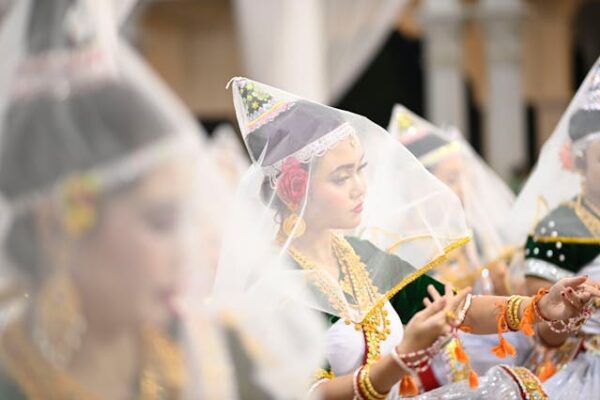Brief Overview of Majuli
Majuli, the largest river island in the world, is nestled in the Brahmaputra River in Assam, India. This enchanting island is not only a geographical wonder but also a vibrant cultural and spiritual hub, particularly for Assamese Vaishnavism. Majuli’s unique blend of natural beauty and rich cultural heritage makes it a treasure trove of tradition and art.
Significance of Masks (“Mukha” in Assamese)
Integral Part of Traditional Culture and Rituals
Masks, known as “Mukha” in Assamese, are an integral part of Majuli’s traditional culture and rituals. They play a vital role in religious performances and theater, especially in the Satras (monasteries) that dot the island. These masks are more than just artistic creations; they are symbols of spiritual expression and cultural identity.
Used in Religious Performances and Theater
In Majuli, masks are predominantly used in religious dramas known as Bhaona. These performances, rooted in Assamese Vaishnavism, depict various mythological stories and characters, bringing ancient legends to life with vivid visual appeal and emotional depth.
Historical Background
Origins
The tradition of mask-making in Majuli can be traced back to the 15th century, introduced by the saint-scholar Srimanta Sankardeva. Sankardeva, a pivotal figure in Assamese culture, used masks in Bhaona to portray mythological characters, enhancing the storytelling experience and making it more engaging for the audience.
Evolution
Over the centuries, the craft of mask-making has evolved under the guidance of the Satras. While the basic techniques and materials have remained traditional, artisans have adapted their designs to reflect contemporary themes and preferences, ensuring the craft remains relevant and vibrant.
Cultural Importance
Religious and Mythological Themes
Majuli’s masks predominantly depict characters from Hindu epics like the Ramayana and Mahabharata. They represent a wide array of figures, including deities, demons, and animals, each crafted with intricate detail and vibrant colors to capture their essence and significance.
Role in Bhaona Performances
In Bhaona performances, masks are essential for bringing characters to life. They enhance the visual and emotional appeal of the dramas, making the stories more immersive and impactful. The use of masks allows performers to embody mythological figures, adding a layer of authenticity and tradition to the performances.
Craftsmanship
Materials and Techniques
The art of mask-making in Majuli involves traditional methods passed down through generations. Masks are typically made from bamboo, clay, cloth, and cow dung. Here’s a glimpse into the process:
- Structure Creation: The basic structure is made with split bamboo arranged in a hexagonal shape. For flexibility, artisans use ‘jaatibaah’ (2-3 years old bamboo).
- Covering: The structure is covered with cotton cloth dipped in potter’s clay. A mixture of clay and cow dung is applied to the cloth and dried in sunlight.
- Detailing: Once dried, the mask is further detailed with glued fabric dipped in clay.
- Painting: After complete drying, the mask is painted with natural colors, adding the final touches to its appearance.
Intricate Detailing and Vibrant Colors
The craftsmanship involved in mask-making is meticulous, with artisans focusing on intricate detailing and vibrant colors. Each mask is a unique piece of art, reflecting the skill and creativity of the craftsman.
Types of Masks
Majuli’s masks can be categorized into various types based on their morphology and structure:
Morphological (Loukik) Masks
These masks represent human and animal characters and are used to portray realistic figures in performances.
Structural (Oloukik) Masks
These masks depict supernatural characters and are divided into three types:
- Mukh Mukha: Full-face masks for main characters.
- Bor Mukha or Su Mukha: Large masks that cover the entire body of the performer.
- Lutukai or Lutukori Mukha: Smaller masks compared to Su Mukha, used for less prominent characters.
Additionally, there are headgear or partial masks for supporting roles, each varying in size and complexity based on the character they represent.
Master Artisans
Notable Artisans and Families
Majuli is home to several notable artisans and families dedicated to the art of mask-making. These artisans often receive training and apprenticeship within the Satras, ensuring the continuation of this traditional craft.
Training and Apprenticeship
The training process involves learning traditional techniques, understanding the cultural significance of different masks, and mastering the art of intricate detailing and painting. This apprenticeship system ensures that the knowledge and skills are passed down through generations.
Contemporary Relevance
Preservation Efforts
Efforts to preserve the art of mask-making in Majuli are underway, with initiatives by the government and cultural organizations. Workshops and exhibitions are organized to promote the craft and raise awareness about its cultural significance.
Tourism
Majuli’s rich cultural heritage, including its mask-making tradition, attracts tourists interested in culture and heritage. Visitors have the opportunity to learn about the craft, witness performances, and even participate in workshops, making their visit to Majuli an enriching experience.
Challenges
Despite its cultural significance, the craft of mask-making faces challenges such as modernization and reduced interest among the younger generation. There is a need for sustainable support and promotion to ensure the survival of this unique art form.
Conclusion
Cultural Heritage
The masks of Majuli are a symbol of Assam’s rich cultural heritage. They represent centuries of tradition, spirituality, and artistic expression. Preserving and promoting this unique art form is crucial to maintaining the cultural identity of Majuli and Assam.
Future Prospects
With increased recognition and global appreciation, the future of Majuli’s mask-making tradition holds promise. Local and international efforts can play a significant role in sustaining this craft, ensuring it continues to thrive and inspire future generations.




